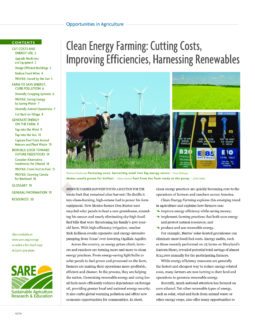Specific agricultural and forestry practices can capture and store, or “sequester,” carbon, which can be released into the atmosphere as carbon dioxide (CO2), a primary greenhouse gas. According to the Intergovernmental Panel on Climate Change (IPCC), roughly 100 billion metric tons of carbon could be sequestered in the world’s soils during the next 50 years, offsetting 10–20 percent of carbon emissions from fossil fuels.
Carbon storage is also good for soils. It increases organic matter, improving soil structure and water infiltration, which can improve yields and profits for growers. At Pennsylvania’s Rodale Institute, the long-running Farming Systems Trial showed that after 23 years, organic systems each stored about 1,000 pounds of carbon per acre per year due to cover crops and crop rotations. The conventionally fertilized system did not accumulate significant amounts of carbon.
To effectively store carbon in soils:
- Add organic materials, such as manure and cover crops.
- Reduce or eliminate tillage.
- Return the maximum possible crop residue to the soil.
- Plant a permanent cover.
Finding the best approach to tilling to mitigate greenhouse gases is a bit tricky, however. To store carbon, no-till is certainly best. The more undisturbed the soil the better, as mixing and aerating feeds otherwise dormant microorganisms that will hungrily metabolize carbon and then release it as CO2. However, no-till systems can also increase emissions of nitrous oxide (N2O) — a far more potent greenhouse gas than CO2. Scientists are not completely sure of the processes and conditions that increase N2O emissions but believe it is due to the higher soil moisture levels and increased fertilizer use that can occur under no-till.
To minimize release of N2O, no-till producers should use nutrient management plans, nutrient testing and the “pre-sidedress nitrate test” (PSNT) to help synchronize nitrogen application and availability with crop demand.
Storing carbon may also offer financial benefits. In the early 2000s, the Chicago Climate Exchange began offering farmers the opportunity to earn money for practices that reduce emissions of major greenhouse gases by buying and selling carbon credits. Credits sold in 100-ton units, too large for individual farmers, so both the Farmers Union and Farm Bureau organized large blocks of farmers — representing about one million acres from each organization — to sell credits.
When the Climate Exchange program began, carbon traded at 50 cents per acre for land in no-till. By 2007, the going rate on the same land was about $2 per acre. Alfalfa and some grasses in 2007 traded for about $3 per acre; forest land got $4–$20 per acre, depending on the type, age and location of the trees; and dairy farmers capturing methane earned about $20–$30 per cow per year.
However, carbon prices were dependent on market forces and an expectation that mandatory limits would be set. When this failed to happen, rates plummeted, and in 2010 the Farmers Union suspended the program. Until mandatory caps are placed on carbon emissions, the value of carbon will remain dependent on government legislation and programs that set national, state or local limits on the amount of carbon that can be released into the atmosphere.
